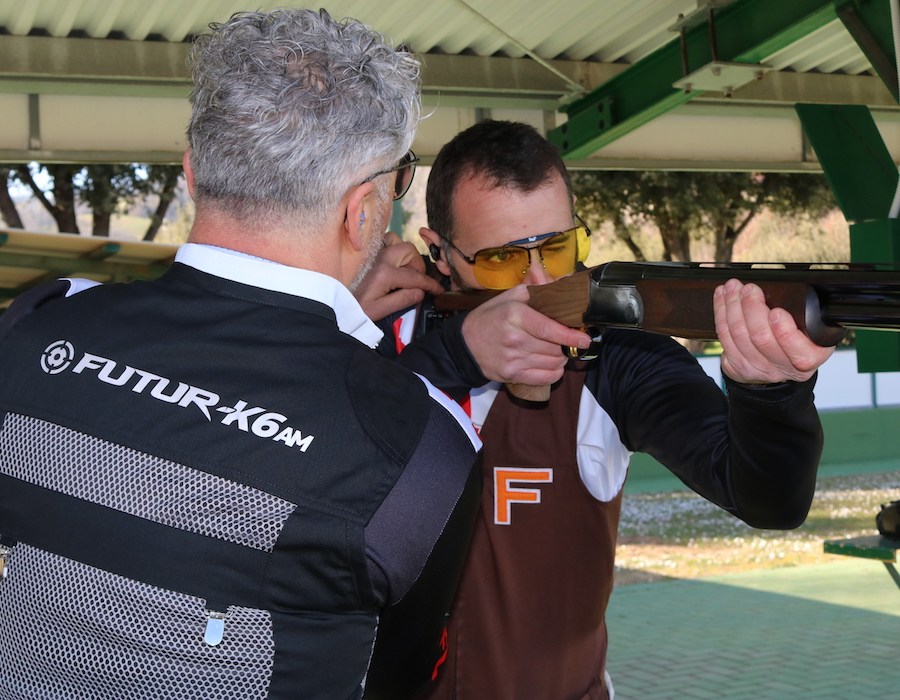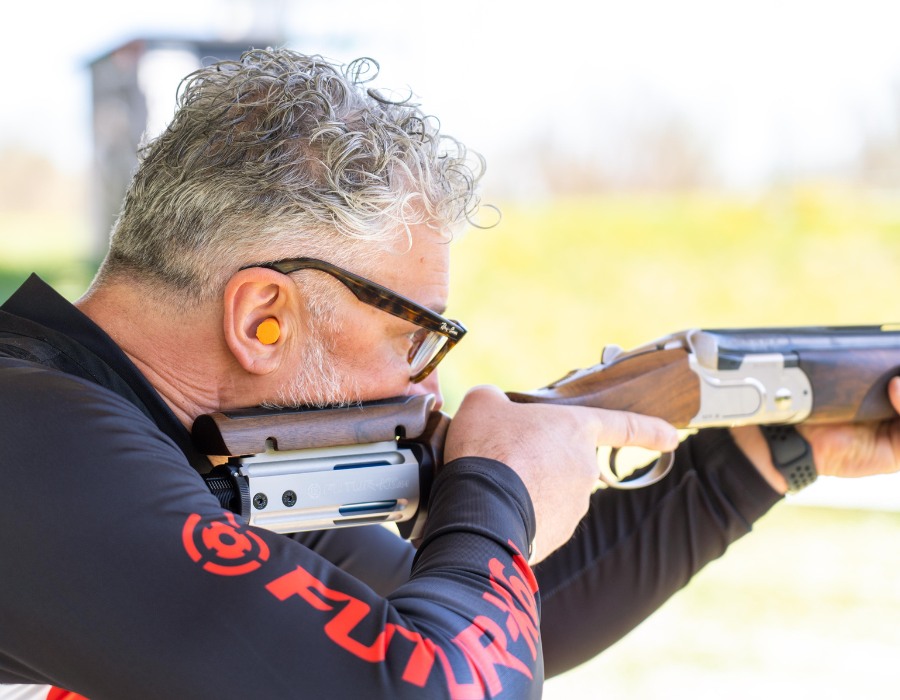Hitting a clay pigeon, whether you practice the Trap or Skeet specialty, is not difficult for those who have a minimum of confidence with smooth-bore shotguns and practicality with shooting in motion.
The difficult part is breaking all the targets in a series, one after the other in a constant way. However, it gets even more difficult to start breaking them again after you have missed one. When this happens, the solution is to quickly analyze the reason behind the error, without getting discouraged.
Let’s now try to analyze the most frequent errors that affect the performance of those who practice clay pigeon shooting, so you can avoid them.

What are the most common clay pigeon shooting errors?
Having the correct knowledge of the technique and the right means to practice clay pigeon shooting are solutions that will help shooters avoid many of the most common and frequent errors.
Anyone who intends to practice at shooting ranges assiduously and wants to achieve results—or find practical advice to become a professional shooter—should know that:
- Your position on the platform is fundamental
- Training must be constant
- You must have a customized shotgun with a stock adjusted to your build
- You must fire ammunition that respects your reaction times and shooting style
These simple rules already represent the first step towards obtaining good results.
Let’s take a look at the most frequent errors in clay pigeon shooting.

1. Shouldering the shotgun incorrectly
Many professional shooters believe that the shouldering phase on the platform, even before calling the target, is a crucial moment because at this moment it becomes clear whether the shooter will be able to break the target or not.
In fact, in both Trap and Skeet, many novice shooters mistakenly position their barrels too low when aiming for the pit, or hold the shotgun at an incorrect angle in Skeet while waiting for the target to show.
These errors force the shooter to make excessive movements which can cause two fundamental problems:
- The first is that the line of sight, being positioned too low or angled with respect to the target, leads to wasting time in the phase of interception and locking of the target. In this way, it produces shots fired late or excessively early, in an attempt to recover, allowing the target to reach extreme distances where breaking the target becomes increasingly difficult
- The second drawback concerns the excessive number of movements that the shooter will make in search of the target’s trajectory which will produce incorrect aiming settings.
A correct shouldering also depends on how you hold it. The shotgun must be firmly in place before calling the target and before pulling the trigger.
Otherwise, you will have a weak grip on the gun which will become unstable especially after having fired the first shot, making it difficult to try to recover the second barrel.
To refine this phase, avoiding errors in the shouldering phase and the solidity of the grip, you should:
- Make a few calls without firing
- Training not only on the field but also at home, perhaps in front of a mirror
We must emphasize that a firm grip does not mean rigid, but secure!

2. Closing one eye when aiming at the clay pigeon
One of the most common errors made when firing a shotgun is closing the eye that is not in line with the rib.
Some believe that this improves aiming, as the dominant eye is needed to hit the target.
The concept may be right but we may not always know which eye is our dominant eye, so in the meantime, we could lose many targets.
Shooting with both eyes open not only avoids this problem but increases the field of view and the ability to readily grasp the target as soon as it shows up.
Furthermore, not closing the other eye allows “our targeting system” to collect a whole range of information, such as:
- Trajectory
- Angle
- Speed of the target
3. Poor torso rotation
The poor ability to rotate the torso or a poor elasticity of this part of the body produces difficulty in following and hitting the target, especially on side shots, failing to bring the right advance.
Poor rotation of the torso can also depend on an incorrect position on the platform which prompts the shooter to move the shotgun with their arms instead of moving their torso.
This occurs especially in the terminal phase of the action when the trigger is pulled, causing a general imbalance of the whole body.
The ability to rotate the torso, therefore, depends on assuming a correct position on the platform, with the feet and legs perfectly in line.
To test the ability to rotate and correct the position, just follow an imaginary lateral target, hare in Compack, or cross in the Trap; when you feel a tension in the posterior muscle of your leg, it means that you will have reached the maximum opening.
By evaluating the extent of this, it is clear whether corrections must be made to the basic position to improve it, favoring a more elastic and proactive rotation.
4. Tilting your head from the “pull” until the plate breaks
Duck, you sucker!
This is not just the paraphrase from a famous Sergio Leone film, but the fact that the shooter’s head must go straight down on the stock, without tilting to the side to try to align the eye with the rib.
This position must be maintained during the whole phase that goes from the “pull” to the breaking of the plate.
It often happens that many shooters, to observe the target when it starts, or to assess where the shot is aimed, raise their heads just before starting to follow the trajectory or pull the trigger.
In this way, the correct eye-rib alignment and the line of sight are lost and therefore the possibility of centering the shot.
Another error concerning the correct alignment of the neck and head in the axis occurs when waiting for the recoil.
In fact, when you fire ammunition that is too fast and you don’t have good cushioning systems in the stocks, you tend to stiffen your neck just before pressing the trigger while waiting for the recoil, changing the position of your head and therefore the alignment.
A correct position, also facilitated by the modern cushioning systems contained in the new technical stocks, such as the Futur-K6AM, requires the shooter’s whole body instead to accommodate the shotgun, absorbing the little recoil that remains with the whole body to neutralize it, without opposing that force with rigidity.

5. An imprecise shooting method
Essentially there are two types of shooters on the platform:
- Those who shoot instinctively
- Those who prefer to follow the target smoothly and then hit it
In both cases, errors can be made that will result in a “zero”.
Instinctive shooting is one of the most fascinating and aesthetically beautiful methods, as it allows the shooter to strike the target as soon as it appears in their field of vision.
But it is a shot that not everyone is able to do and that requires above all a firm shooting setting and a perfect position as the shooter who uses this technique aims very little, or does not aim, at the target, but shoots almost with a dry and decisive movement.
This can cause easy errors because if you anticipate the shot too much with the shot pattern still too closed, or you don’t have the gun well-aimed, the target will fly away unscathed.
The shooter who uses a more fluid technique, on the other hand, and follows the trajectory of the target to shoot with the shotgun in motion may also have the possibility to correct themselves during the trajectory by better adjusting the aim.
The problem, in this case, could be the excessive amount of time it takes to shoot, which would take the target out of the useful range of the shotgun, making it unreachable by the shot.
6. Too many movements on the platform before the shot
Finally, we should remember that on the platform it is necessary to make a few but essential movements, from when you position yourself until the plate breaks.
Therefore, it is necessary to revise and review the movements that are performed, even with the shotgun unloaded, to eliminate the superfluous ones and memorize, by automating them, the fundamental ones.


